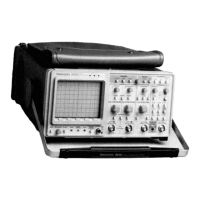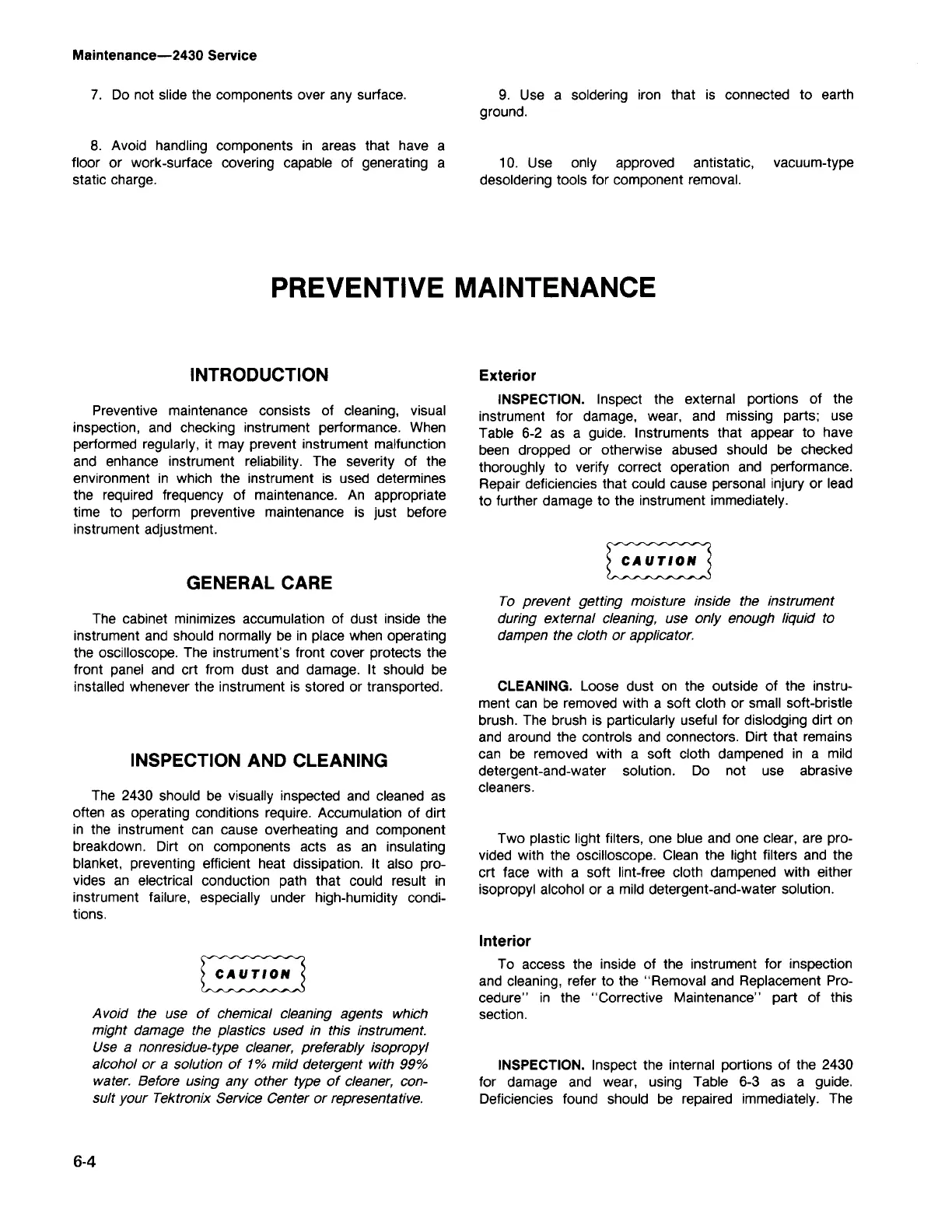INSPECTION. Inspect the internal portions of the 2430
for damage and wear, using Table 6-3 as a guide.
Deficiencies found should be repaired immediately. The
Interior
To access the inside of the instrument for inspection
and cleaning, refer to the "Removal and Replacement Pro-
cedure" in the "Corrective Maintenance" part of this
section.
Two plastic light filters, one blue and one clear, are pro-
vided with the oscilloscope. Clean the light filters and the
crt face with a soft lint-free cloth dampened with either
isopropyl alcohol or a mild detergent-and-water solution.
CLEANING. Loose dust on the outside of the instru-
ment can be removed with a soft cloth or small soft-bristle
brush. The brush is particularly useful for dislodging dirt on
and around the controls and connectors. Dirt that remains
can be removed with a soft cloth dampened in a mild
detergent-and-water solution. Do not use abrasive
cleaners.
To prevent getting moisture inside the instrument
during external cleaning, use only enough liquid to
dampen the cloth or applicator.
Exterior
INSPECTION. Inspect the external portions of the
instrument for damage, wear, and missing parts; use
Table 6-2 as a guide. Instruments that appear to have
been dropped or otherwise abused should be checked
thoroughly to verify correct operation and performance.
Repair deficiencies that could cause personal injury or lead
to further damage to the instrument immediately.
6-4
Avoid the use of chemical cleaning agents which
might damage the plastics used in this instrument.
Use a nonresidue-type cleaner, preferably isopropyl
alcohol or a solution of 1% mild detergent with 99%
water. Before using any other type of cleaner, con-
sult your Tektronix Service Center or representative.
The 2430 should be visually inspected and cleaned as
often as operating conditions require. Accumulation of dirt
in the instrument can cause overheating and component
breakdown. Dirt on components acts as an insulating
blanket, preventing efficient heat dissipation. It also pro-
vides an electrical conduction path that could result in
instrument failure, especially under high-humidity condi-
tions.
INSPECTION AND CLEANING
The cabinet minimizes accumulation of dust inside the
instrument and should normally be in place when operating
the oscilloscope. The instrument's front cover protects the
front panel and crt from dust and damage. It should be
installed whenever the instrument is stored or transported.
GENERAL CARE
Preventive maintenance consists of cleaning, visual
inspection, and checking instrument performance. When
performed regularly, it may prevent instrument malfunction
and enhance instrument reliability. The severity of the
environment in which the instrument is used determines
the required frequency of maintenance. An appropriate
time to perform preventive maintenance is just before
instrument adjustment.
INTRODUCTION
PREVENTIVE MAINTENANCE
10. Use only approved antistatic, vacuum-type
desoldering tools for component removal.
9. Use a soldering iron that is connected to earth
ground.
8. Avoid handling components in areas that have a
floor or work-surface covering capable of generating a
static charge.
7. Do not slide the components over any surface.
Maintenance-2430 Service

